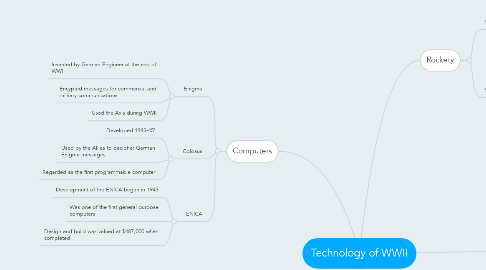
1. Computers
1.1. Enigma
1.1.1. Invented by German Engineer at the end of WWI
1.1.2. Encypted messages for commercial and military communications
1.1.3. Used the Axis during WWII
1.2. Colosus
1.2.1. Developed 1943-45'
1.2.2. Used by the Allies to decipher German Enigma messages
1.2.3. Regarded as the first programmable computer
1.3. ENICA
1.3.1. Development of the ENICA began in 1943
1.3.2. Was one of the first general purpose computers
1.3.3. Design and build was valued at $487,000 when completed
2. Atomic Weapons
2.1. WWII was coined the "Physicist War" as the Allies an Axis powers raced to develop the first atomic weapons
2.2. Thin Man was developed by the Allies as a part of the infamous Manhattan Project . It was first Atomic weapon used in war, and was detonated over Hiroshima on Aug 6th 1945.
2.3. Fat Man was also developed by the Allies as apart of the Manhattan Project. It was the second and last atomic weapon used in war, and was detonated over Hagasaki on Aug 9th 1945
3. Rockety
3.1. Vengeance 1
3.1.1. Developed by Robert Lisserr
3.1.2. First Launch: Summer 1944
3.1.3. Flew at low altitude and relied upon a mechanical "autopilot" for guidence
3.2. V2
3.2.1. Based on design by Wernher von Braun
3.2.2. Thousands deployed in Sept 44'
3.2.3. Reached the boarders of space and dropped straight down upon its intended targets
3.2.4. Basis for U.S. and GB space missile programs
4. Radar
4.1. Sir Robert Watson-Watt produced the first system in 1935 and by 1939 the system was used to detect aggressors on Englands south and east costs
4.2. Relied upon semiconductor crystal "rectifier"
4.3. R&D of crystal growing eventually lead to the development on the first transitors
5. Medical Advancements
5.1. Penicillin
5.1.1. Discovered in 1928 by Alexander Flemming
5.1.2. Mass production in 1940
5.1.3. By 1945, over 600 billion units per year were being produced
5.2. Blood transfusions
5.2.1. First transfusion were performed in the 17th century
5.2.2. At the start of WWI the development of anticoagulants increases the amount of time that blood can be stored. WWI also increased the practice of blood transfusion as demand for this procedure increases with the effects of the war
5.2.3. In 1940 the U.S. Gov't establishes the the national blood collection program
5.2.4. In 1945 the Red Cross had collected over 13 million pints of blood it its effort to provide blood for wounded WWII soldiers
5.3. DDT
5.3.1. First used as a pesticide
5.3.2. Considered a "Wonder Chemical" for it ability to eradicate insects without apparent harm to Humans.
5.3.3. Rachael Carlson (Silent Spring, 1962) brings public attention to the disastrous effects of DTT on humans/animals and their environment, triggering the establishment of the EPA
5.3.4. DDT is banned for agricultural use worldwide in 2001, but is still permitted in small quantities in some country to fight disease carrying insects
